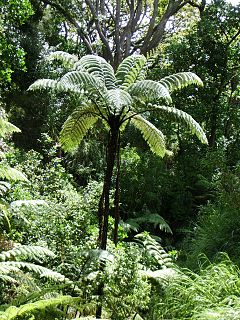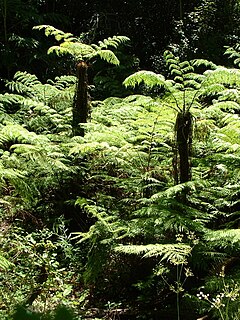
The Cyatheaceae are the scaly tree fern family and include the world's tallest tree ferns, which reach heights up to 20 m. They are also very ancient plants, appearing in the fossil record in the late Jurassic, though the modern genera likely appeared in the Cenozoic. Cyatheaceae are the largest family of tree ferns, including about 500 species. Cyatheaceae and Dicksoniaceae, together with Metaxyaceae and Cibotiaceae, are a monophyletic group and constitute the "core tree ferns". Cyatheaceae are leptosporangiate ferns, the most familiar group of monilophytes.

Cyathea medullaris, popularly known as the black tree fern, is a large tree fern up to 20 m tall. It is distributed across the south-west Pacific from Fiji to Pitcairn and New Zealand. It is called mamaku, katātā, kōrau, or pītau in the Māori language.
Cyathea acrostichoides is a species of tree fern native to the Maluku Islands and Western New Guinea, where it grows in forest and disturbed sites at an altitude of 650–1100 m. The trunk is erect and usually 1–3 m tall. Fronds are bipinnate and 1–2 m long. The stipe is slender and covered with spines. It is sparsely covered with medium brown scales. Sori cover most of the underside of fertile pinnules. C. acrostichoides lacks indusia.
Cyathea alderwereltii is a species of tree fern endemic to Mount Sago in central Sumatra, where it is nevertheless abundant and grows in forest at an altitude of 1000–1500 m. It has an erect trunch which may be 4 m tall or more. Fronds are bi- or tripinnate and 1–2 m long. The stipe of this species is spiny at the base and covered with scattered scales that are dark brown, glossy, and have a narrow paler margin. Sori are produced near the fertile pinnule midvein and are covered by small, brown scale-like indusia.
Cyathea alleniae is a species of tree fern native to the Malay Peninsula, where it grows in forest margin on steep ground at an altitude of approximately 1200 m. The trunk is erect, about 4 m tall and 15 cm in diameter. It is usually unbranched, but may branch to form several small crowns. Fronds are bi- or tripinnate and 1–2 m long. The stipe is spiny at the base and at least partially covered by scales. Typically of section Alsophila, these scales are dark brown, glossy, and have fragile edges. Sori occur near the midvein of fertile pinnules and are covered by firm, brown indusia that resemble scales in appearance.
Cyathea amintae is a species of tree fern native to Puerto Rico, where it grows in shaded areas and cloud forest at an altitude of 1000–1200 m. The erect trunk may be 1.3 m tall and approximately 5 cm in diameter. Fronds are pinnate and up to 1.6 m long. The rachis is often purplish brown and covered with scales, usually on the underside. The scales range in colour from golden brown to bicoloured. Sori occur along each side of the pinnule midvein and indusia are cup-like.

Cyathea brevipinna is a species of tree fern endemic to the higher parts of Mount Gower on Lord Howe Island, where it grows in exposed areas at an altitude of about 790 m. The trunk is erect and may reach 3 m in height. It is often covered with reddish brown scales and stipe bases. This species may produce stolons at ground level. Fronds are tripinnate, densely crowded, and up to about 3 m long. The stipe is brown and sometimes warty after scales fall off. The scales are long, glossy dark brown, with a distinctly narrow apex and fragile paler edges. Sori are attached to deeply divided fertile pinnules that may uncurl over the sori. Indusia are firm and large. C. brevipinna is a stunted plant with short pinnae.
Cyathea brooksii is a species of tree fern native to Cuba, Hispaniola and Puerto Rico, where it grows on serpentine soils in shaded ravines, along streams, and on forested slopese at an altitude of 250–950 m. The trunk is prostrate and only about 6 cm in diameter. Fronds are pinnate or bipinnate and up to 2 m long. The base of the rachis is covered with blackish scales that have a paler margin. Sori occur in two rows, one along each side of the pinnule midvein.
Cyathea callosa is a species of tree fern endemic to Luzon in the Philippines, where it grows in midmontane forest. The trunk is erect and about 3 m tall or more. Fronds are bi- or tripinnate and 1–2 m long. The stipe is spiny and covered with scattered scales that are dark and have pale, fragile edges. Sori occur near the midvein of fertile pinnules and are covered by thin, pale indusia.

Cyathea capensis is a regionally widespread and highly variable species of tree fern. It is indigenous to Southern Africa and South America.
Cyathea caudata is a species of tree fern native to the islands of Luzon and Mindanao in the Philippines, where it grows in montane forest. The trunk is erect and up to 4 m tall or more. Fronds are bi- or tripinnate and 1–2 m long. The stipe is warty and covered with dark, narrow, glossy scales. Sori are borne near the midvein of fertile pinnules and are protected by firm, brown indusia.
Cyathea costalisora is a species of tree fern native to western New Guinea, where it grows on the edges of forest and in moist hollows at an altitude of 1900–3225 m. The trunk is erect, up to 4 m tall and may branch near the base. Fronds are bi- or tripinnate and 1-1.5 m long. The stipe is warty, especially where scales have fallen. The scales are pale and have a distinctive dark glossy central region, with a paler dull margin. Sori are round and occur near the fertile pinnule midvein. They are covered by firm, dark indusia that are cup-like in appearance.
Cyathea costulisora is a species of tree fern native to Sumatra. The trunk is erect and usually 1–4 m tall. Fronds are bi- or tripinnate and 1–2 m long. The stipe is covered with warts and scales. The scales are either pale and glossy or dark and flat. Sori occur near the fertile pinnule midvein and are covered by large, firm, brown indusia.

Cyathea cunninghamii, also known as the gully tree fern and slender tree fern, is a species of tree fern indigenous to New Zealand including North Island, South Island and Chatham Islands; also to Victoria, possibly New South Wales, southeastern Queensland and Tasmania in Australia. It grows in damp forest, often emerging from stream gullies and riverbanks. Brownsey noted that it has a lower tolerance for drought than other species of Cyathea. The erect trunk may be 20 m tall and is usually 6–15 cm in diameter, occasionally as much as 20 cm. Fronds are tri- to tetrapinnate and 3 m or more in length. The rachis and stipe are slender, black brown, warty and covered with brown scales. Sori occur along each side of the pinnule midvein and are covered by hood-like indusia. C. cunninghamii is an uncommon and slow-growing tree fern.
Cyathea edanoi is a species of tree fern endemic to Luzon in the Philippines, where it grows in montane forest at an altitude of about 1300 m. The trunk is erect and 1–2 m tall. Fronds are bi- or tripinnate and approximately 1 m long. The stipe is covered in dark, glossy scales that have narrow, fragile edges. Sori occur near the midvein of fertile pinnules and are covered, sometimes half-covered, by large, firm, brown indusia.
Cyathea fenicis is a species of tree fern native to the Philippines, Taiwan, and Orchid Island, where it grows in wet forest, forest margins and on hillsides. The trunk is erect, up to 1 m tall and about 6 cm in diameter. Fronds are tripinnate and 1.5–2 m long. Characteristically of this species, the lowest pinnae are usually reduced. The stipe is spiny and ranges in colour from brown to purple-dark brown. It bears two types of scales: long dark brown scales as well as minute brown ones. Occasionally the scales are pale. Sori are round and arranged in two rows, one on either side of the pinnule midvein. They are covered by very small indusia that resemble scales in appearance.
Cyathea squamulata is a species of tree fern native to the Malay Peninsula, Sumatra, Java, Borneo and the southern Philippines, including the Sulu Archipelago, where it grows in forest from the lowlands to an altitude of about 1500 m. The trunk is erect and up to 2 m tall. Fronds are pinnate or bipinnate and approximately 1.5 m long. The stipe is covered in densely packed firm, medium brown scales. Sori occur near the fertile pinnule midvein and lack indusia.
Cyathea hunsteiniana is a species of tree fern endemic to eastern New Guinea, where it grows in rain forest at an altitude of 1300–2000 m. This species has a slender, erect trunk up to 1 m tall and about 3 cm in diameter. Fronds are bipinnate and approximately 1 m in length. Scattered scales cover the stipe. They are dark brown in colouration and have a broad paler margin and fragile edges. Round sori are borne one or two per fertile pinnule segment. The sori are protected by deep, firm indusia that are cup-like in appearance.
Cyathea imbricata is a species of tree fern endemic to Western New Guinea, where it grows in open forest at an altitude of 3240 m. The trunk of this plant is erect and approximately 2 m tall. Fronds may be bi- or tripinnate and are usually less than 1 m in length. The stipe is dark, spiny, and covered with caducous scales. These scales are glossy brown in colouration and have a paler margin and fragile edges. Sori are borne in groups of one to four per pinnule lobe. They are protected by firm indusia.

Cyathea smithii, commonly known as the soft tree fern or kātote, is a species of tree fern from New Zealand.









